The Most Abused Animal On The Planet – The Chicken
Posted on January 29, 2021
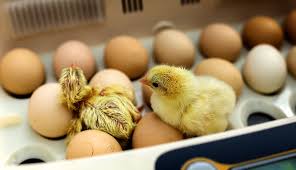
In this article End Animal Slaughter Contributor Dr Lynley Tulloch remembers a newly hatched chick, and laments the cruel fate of industrially raised chickens the world over.
I have always had a special place in my heart for chickens. As a 14-year-old I was taken by a friend’s father for a trip through his poultry farm in Tuakau, situated in the North Island of New Zealand. That was about 40 years ago now, but it seems like yesterday. I was deeply shocked by the huge macerator which was presented as a killing machine for day-old chicks. As an animal lover I could barely believe what I was seeing and hearing, and my rescue instincts were instantly activated. Trailing behind my friend and her father I noticed a small late-hatching chicken on a tray among many empty egg shells. I asked what would happen to him or her and was told s/he would be killed.
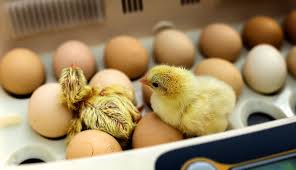
Fifty percent of chickens born in a hatchery will die a frightening and painful death within 24 hours. (Image source: Infovetdurgi.com)
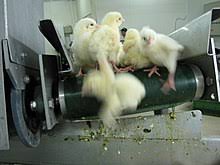
Unwanted baby chicks travelling on a conveyor belt and dropping into whirling blades. (Image source: Wikipedia)
Stuffing the baby chick under my jersey I took him home to this friend’s house where I was staying the weekend. Tentatively I showed her, suggesting we find some food for the chick. My friend betrayed me and told her father, who promptly took the chick outside and broke his neck. The legacy of that one chick is that I still carry him or her in my heart, and think of them on a regular basis.
The current Code of Welfare for broiler (meat) chickens states that for chickens who require ’emergency humane destruction’ the following methods are applicable:
– Electrical stunning followed by neck dislocation and exsanguination
– Neck dislocation alone
– Gas, using a mixture of inert gases and carbon dioxide
– Immediate fragmentation/maceration for unhatched eggs and day-old chicks
So the great old maceration machine is still in action for ’emergency humane destruction’ of fragile day-old chicks who are not profitable and treated as ‘waste’. Welcome to the world little ones!
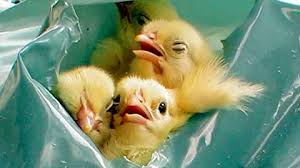
In some hatcheries one-day-old chicks, mainly males as they cannot produce eggs, are gassed as an alternative to maceration. (Image source: kinderworld.org)
There are few more tragic animals on this planet than factory-farmed chickens. Whether bred for their meat (broiler chickens) or eggs, these chickens suffer immensely. For example, meat chickens are only between 32-42 days old when killed and processed, and they spend their entire lives in an artificial environment. They are bred to grow fast and will double in size every week. This often causes them to go lame and be unable to reach their food. Many die of heart and/or organ failure even before slaughter weight. From the very beginning to the very end, they live a tortuous life of suffering.
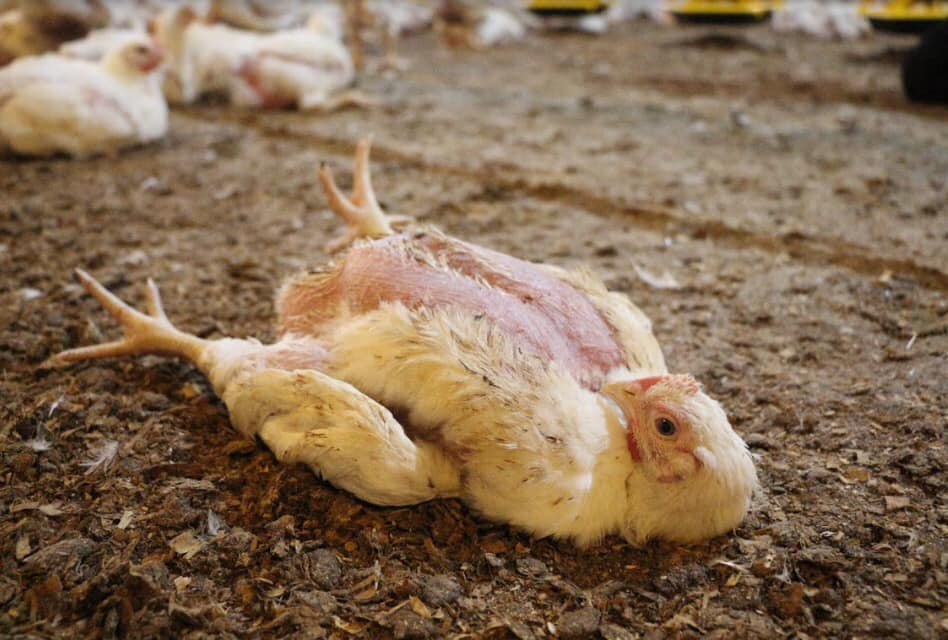
Many broiler chickens become lame, and some have organ failure, even before slaughter weight at 5 or 6 weeks old. (Image Source: Direct Animal Action)
The vast majority of chickens bred for their meat in New Zealand and elsewhere live their entire lives in huge sheds. The sheds can be 150 metres long and 15 metres wide and hold up to 40,000 adult chickens. These hellish environments are maintained through artificial ventilation, lighting and temperature control. If there’s a power cut, as there was a year ago in a huge chicken farm in West Auckland, tens of thousands of chickens can die of suffocation.
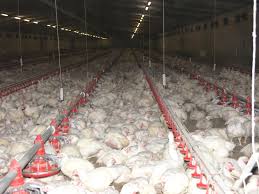
Bred to grow at a fast rate so they are more profitable for the farmer, broiler hens have approximately the size of an A4 sheet of paper to live on. (Image Source: https://www.plantbasednews.org/)
The growth in production and consumption of chicken bodies since the 1980s is phenomenal. Around 100 million are now raised and killed every year in New Zealand, while worldwide, the number tops fifty billion. Recent news from the US is that the Biden Administration has officially withdrawn a pending rule by the previous administration that would have permanently allowed chicken slaughter lines to speed up from an already lightning-fast 140 birds per minute, to 175 per minute. This is a small win for the chickens that barely got noticed, but then few people really notice these birds unless they are on their dinner plates.
The maceration machine killing method is known as ‘instantaneous fragmentation’. Basically, its like putting a wee chick in a blender and turning it on. It happens to all day-old male chicks in the laying hen industry on a daily basis. As you are reading this chicks are being thrown into industrial-size blenders so that people can have their eggs sunny side up.
The recommended ‘best practice’ for killing chickens as emergency humane destruction is as follows:
“Chickens should be humanely destroyed using a mixture of inert gases with a low concentration of carbon dioxide (i.e. up to 30%) to produce an atmosphere with less than 2% oxygen by volume.”
Does it sound humane to you? To me it sounds like suffocation, which would be very painful and distressing to the chicks.
If a chicken bred for meat makes it through the first five to six weeks of life and ends up being slaughtered, it can expect a lot more distress. After the stress of being pursued by a ‘chicken catcher’ and stuffed into crates, birds are transported to the slaughterhouse where they are shackled onto an assembly line and hung upside down. They then proceed to a water bath where an electrical current passes through their brain, intended to stun them. Almost fully automated, this is by no means a perfect process. Mistakes and malfunctions occur. I have seen videos of distressed birds entering the electric bath flapping their wings, and some are still flapping them when they exit the bath. An ineffective stun means that the chickens will have their throats slit, and bleed out, while fully conscious.
Birds can also be stunned in New Zealand with a mixture of inert gases plus up to 30% carbon dioxide to produce an atmosphere with less than 2% oxygen by volume. Birds undergoing this method gasp and flap their wings in distress.
These birds did not ask to be born. They were bred by humans with the sole intent of eating them and profiting from their bodies. It is a monstrous thing to do to animals. Don’t be fooled by the SPCA ‘tick’ or the Free Range label. There is no humane way to raise and kill a bird in the industrialized systems of today.
For that little chick I failed to save forty years ago – please consider giving up eating chicken meat and eggs.

Lynley Tulloch is an academic, animal rights activist and writer. She has a PhD in sustainability education and ecocentric philosophy
Comments
Comments are closed.


Donna says:
Please help these animals, I donate to compassion in world farming and I’m Vegan, I’m praying other people will start supporting these beautiful creatures
Sandra Kyle says:
Thankyou for your compassion and action for animals Donna. x
Daniella Bal says:
Het is een schande voor de mensheid hoe er met de dieren wordt gehandeld. Ik word ziek van al dat dierenleed. Alle dagen probeer ik de mensen hun ogen te laten opengaan en zien waar ze medeschuldig aan zijn
Sandra Kyle says:
Indeed Daniella. Thankyou for trying to open people’s eyes. x
Tineke says:
Stop this now
Sandra Kyle says:
Amen to that.
Christine says:
Being a part of this cruelty shows the character of someone. Being kind and compassionate shows the character of someone. We can choose how to use our voice. There voice is taken away. Compassion is the voice of love.
Sandra Kyle says:
I love that expression Christine. ‘Compassion Is The Voice Of Love’. xx
Gillian says:
We must stand up for animals and not look the other way
Sandra Kyle says:
Exactly Gillian. Too many people literally look the other way, but social media and people like us are forcing them to confront the realities of our inhumanity to other animals. xx
Mary Aragon says:
This is horrific. I am vegan for the animals first. The coldness and callousness of this breaks me heart. I pray some day humanity will become more humane. I believe it has begun, even if it is in a small way.
Sandra Kyle says:
It has begun Mary. xx